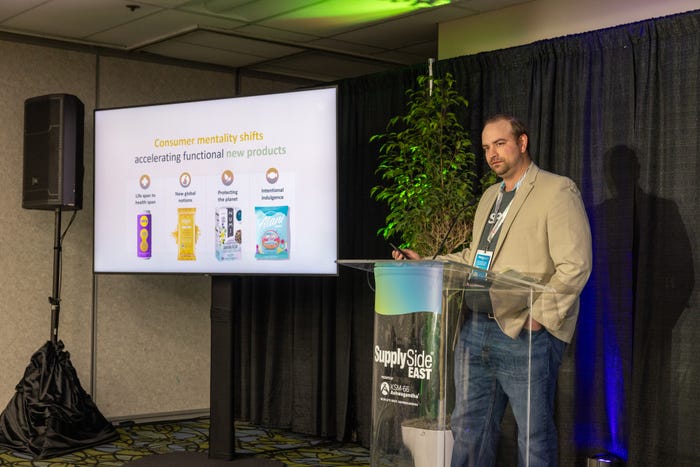Functional foods, beverages take center stage at SupplySide East
During SupplySide East, a panel of three industry professionals discussed why functional food and beverage products are growing at an exponential rate, and which ingredients are primed to advance the category.

At a Glance
- Consumers are demanding more functionality from food and beverages, wanting health benefits alongside taste and indulgence.
- Specific ingredients are trending, such as probiotics and caffeine in beverages, and protein and mushrooms in foods.
- Macro trends are influencing the market, including health span over life span, new global ingredients and sustainability.
SupplySide East’s (SSE) annual show at Meadowlands Exposition Center in Secaucus, New Jersey, continues to be one of the industry’s more “intimate” events. Many participants I spoke with expressed how SSE offers a more compatible setting for meaningful conversations and meetings, which benefit food and beverage ingredient companies, as well as supplement companies, alike.
“SupplySide East is the perfect platform for all things ingredient sourcing, and professionals look to SupplySide as the leading expert voice to gain an informed perspective of the research and science continuously shaping the business,” Danica Cullins, SVP of SupplySide, said. ”The show serves as a meeting point to engage, connect and further discuss the future of the health and nutrition industry through the exploration of the latest products, services, research and regulatory changes propelling the estimated $5.6 trillion global wellness market.”
During the two-day event, which attracted more than 2,500 attendees, I had the honor of moderating the only food-and-beverage-focused education session, “The key ingredient: Levering functional ingredients to power F&B products.” There were a total of 10 education sessions during SSE, which covered everything from women’s health to supply chain threats and opportunities.
The hourlong F&B session highlighted functional ingredients primed to advance the food and beverage category. More specifically, it emphasized why functional food and beverage products are gaining momentum in the industry.
Jeffrey Kamholz, director of sales for SPINS, presented some data surrounding the current functional food and beverage landscape, including various types of ingredients and trends that are starting to emerge, what’s driving the growth in the category, and more importantly, why.
SPINS tracks more than 600 functional ingredients across foods and beverages. When looking at functional food and beverage products, Kamholz explained how functional grocery products are gaining share from frozen and refrigerated products.

Photo courtesy of Bryan Beasley Photography
“What we’re seeing is consumers realizing that you are what you eat,” he said. “The notion of ‘life span to health span’ is such an overlaying theme that people are now realizing, ‘Hey, I can demand more from these traditional categories. I can get the functionality, but I can also get the energy and indulgence. I can have it all.’ I think that companies that are adapting to that [mindset] are the ones that are seeing a lot of growth right now. We’re seeing more of a macro consumer shift as people look to live longer, better lives.”
In specific food and beverage categories, Kamholz explained how “energy continues to be a growth driver.”
Functional foods
For functional food products, yogurt is gaining share of the overall category. Pre- and probiotics are continuing to drive growth in the yogurt category; Refrigerated and plant-based yogurts grew by 6% over the last year. Also popular are single-serve cookies and wellness bars/gels, which saw a growth of 7% and 1%, respectively, over the last year.
When it comes to beverages, energy and sports drinks continue to shine, which experienced 7% growth over the last year. Infant formula and toddler drinks also experienced similar growth (8%), as well as kombucha and other functional beverages (6%). Products that saw a decline in growth included water, surprisingly, as well as single-serve tea and ready-to-drink (RTD) coffee products (all down 5%).
Ingredients within the beverage category that are “consistently outpacing market growth,” according to Kamholz, include green teas/supplements, probiotics, animal proteins and caffeine. He noted how caffeine — with the highest dollar growth at $3 billion since last year — remains the “overall, consistent top performer.”
The “consistent underperformers,” Kamholz said, are docosahexaenoic acid (DHA) products, as well as soy-based foods and animal-and-plant-based proteins, compared to one year ago.

Photo courtesy of Bryan Beasley Photography
Why functional foods, beverages are experiencing growth
The reasoning behind all of these factors? “There are four macro trends [driving these changes],” Kamholz explained. “One, the move from life span to health span. People want to get their nutrients/alternatives to supplements, which is also part of the reason why we’re seeing such a growth in functional beverages like Poppi and Olipop; If you can get those probiotic supplements in a fun soda, why would you take a pill? That’s some of the mentality that we’re starting to see resonating in the field.
“Also, new global notions, such as ayurvedic herbs, turmeric and ashwagandha, are going more mainstream,” he continued. “As well as protecting the planet, which includes recycled, upcycled and regenerative practices — a macro trend of making a good product but also protecting the planet while you’re doing it. And intentional indulgence, which is a really interesting trend because we’re starting to see a Quest product that looks and feels like a traditional Reese’s would, but it’s focused on high protein, energy and functionality. We’re starting to see more and more of this pop up across the stores.”
When diving into more specific health focuses in food and beverage products, there are a variety of factors that come into play. For beverages, energy and hydration remain the top two health focuses, but mood support, cleanse/detox, digestive health and performance are also influential factors, which all experienced growth over the last year.
For foods, caffeine is growing in traditional food categories and not just beverages (up almost 450% since last year), according to SPINS data. “Think energy bars, gels, wellness bars with a caffeine component or even gums and mints,” Kamholz said. “Mushrooms and animal protein [both up 168% since last year] are also experiencing growth.
“High protein, low sugar seems to be the sweet spot for salty categories — chips, pretzels, snacks — while probiotics and fibers supporting the biome [are growing] in confectionery categories, such as frozen yogurt and snacks like Smart Sweets,” he added.
When asked about which generations these products appeal to most, Kamholz, as well as the other two panelists, Risa Schulman, Ph.D., president of Tap-Root, and Philip Teverow, co-founder and CEO of Yolélé, said it “runs the gamut,” though younger generations are certainly influencing certain trends.
“Gen Zers are the most experimental out of everybody, as are Millennials,” Schulman said.
“Our audience [at Yolélé] skews youngish, but this is a setting in which people are focused on putting stuff in their bodies to improve them,” Teverow added. “Old people will sometimes change their habits.”
As a Millennial, I can agree that my generation is willing to try almost any and every food or beverage at least once. But, as data has shown, taste is king, so if you — food and beverage companies, I’m talking to you — want to ensure that we continue to purchase your products, you should make sure they taste good (and provide some added health benefits, too, of course).
SupplySide Network’s next annual event, SupplySide West, is scheduled to take place Oct. 28-31 at Mandalay Bay Convention Center in Las Vegas. As the largest ingredient and solutions show in North America, it brings together more than 20,000 professionals and 1,500 international exhibitors from more than 40 countries. Registration is slated to open in June. For more information, click here.
About the Author(s)
You May Also Like






